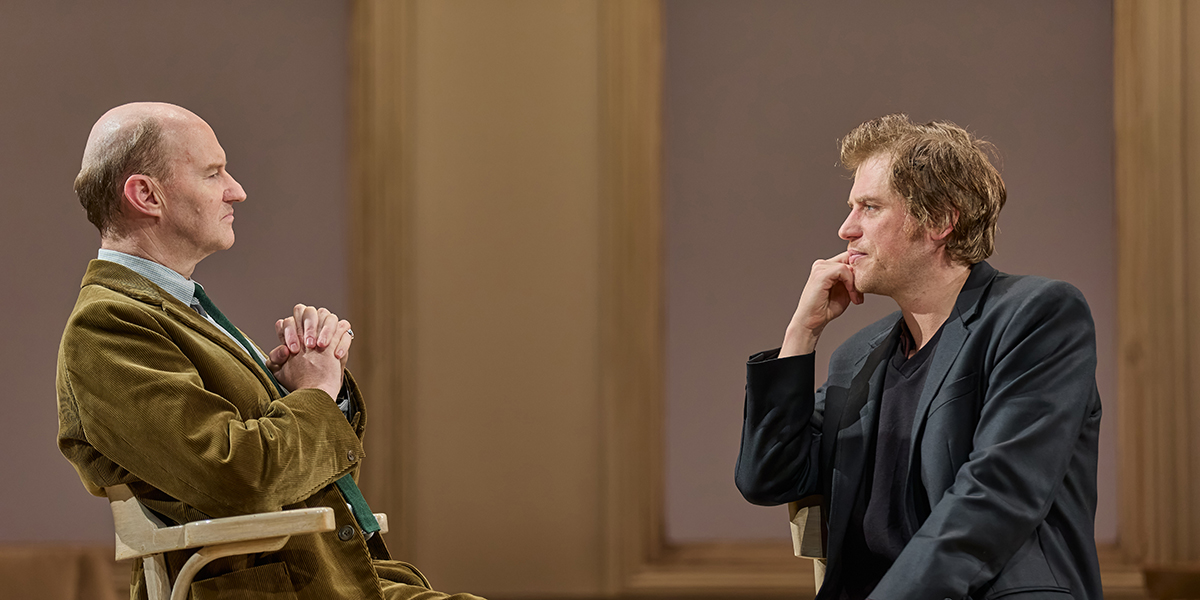Read our review of The Motive and the Cue, which has transferred from the National Theatre to the West End’s Noël Coward Theatre and runs until 23 March.
In 1964, Richard Burton was well on his way to being ruined by Hollywood and was at the centre of a media circus following his (first) marriage to the equally volatile Elizabeth Taylor. Jack Thorne’s play The Motive and the Cue charts Burton’s return to the stage to play Hamlet on Broadway, directed by Sir John Gielgud.
The production has now transferred from the National Theatre to the West End’s Noël Coward Theatre: the venue where Gielgud had his breakthrough in Richard of Bordeaux in 1932 and gave one of his many Hamlets two years later.
It’s a niche, even insular subject matter aimed at a niche audience and it’s hard to say whether it will engage those who are unfamiliar with the cast of characters or indifferent to the nuts and bolts of the rehearsal process. Enjoyment may also depend on one’s tolerance of drunken acting. Sam Mendes’s production is stylish in the way it matches Hollywood glamour with the intellectual rigours of the theatre docudrama-style: time is marked by projections of the days and relevant quotes from Hamlet.
This Hamlet attempts to be a production free from fripperies and is set in a model of the rehearsal room with the actors wearing their own clothes, which in itself is artificial, as Burton buys a stylish black ensemble for his ‘costume’. Es Devlin provides a striking contrast between the classroom-like rehearsal room filled with cardigans in neutral colours and the Burton-Taylors’ impersonally luxurious, tulip-filled hotel suite where Liz sashays around in satin negligees and evening dresses (costumes by Katrina Lindsay).
As Burton, renowned for his extraordinary Welsh baritone voice, Johnny Flynn struggles with his diction but comes into his own when illustrating the actor’s dark side. Playing an angry prince who would kill Claudius without a second thought, he oversteps the mark a with a cruel drunken impersonation of Gielgud’s acting style embellished with camp mannerisms.
It’s no easy task to imitate the force of nature that was Elizabeth Taylor, but Tuppence Middleton ambitiously takes on the role, mediating between Burton and Gielgud and explaining Burton’s rewriting of his origin story. More could have been done with her struggle to be seen as a “serious” actress. Between these two beautiful people, it’s a life filled with sex, alcohol, and self-indulgence that’s fun for a while but becomes limiting.
The pearl of the production is Mark Gatiss as Gielgud, who is much more than an impersonation. It’s a warmly rounded portrait of a man who was catty, kindly and devoted to his craft – and whose homosexuality was an open secret. Born into the Terry theatre dynasty and such a prodigious talent who had played all the major Shakespearean roles by the age of 30, Gielgud has his own ghost in the form of ‘Larry’ Olivier, who won an Oscar for his screen Hamlet (he dismisses such awards as “vulgar”) and is now running the National Theatre, as well as his homosexuality in the years before it was decriminalised.
Luke Norris gives a nuanced performance as William Redfield who felt himself overqualified to play Guildenstern but wanted the chance to be a small part of something great; and Sarah Woodward is no-nonsense as Eileen Herlie, who reprised the role of Gertrude for the production having played it in the Olivier film (in which she was 11 years younger than her on-screen son).
The second act is stronger in building momentum and achieving catharsis, not all of which feels earned (ending with ‘Zadok the Priest’ is bit of a shortcut). One thing is for sure: it’s a play that epitomises the epithet ‘A love letter to theatre’.
The Motive and the Cue is at the Noël Coward Theatre until 23 March. Book The Motive and the Cue tickets on London Theatre.
Photo credit: Mark Gatiss and Johnny Flynn in The Motive and the Cue. (Photo by Mark Douet)


